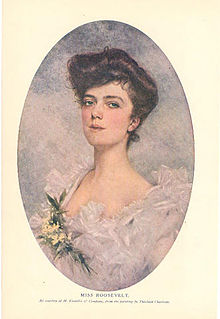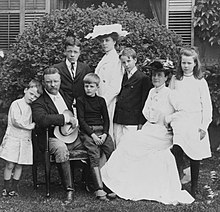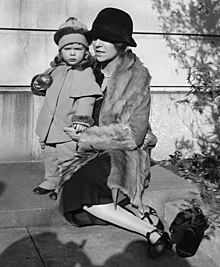Alice Roosevelt Longworth

Alice Lee Roosevelt Longworth (born February 12, 1884 in New York City , † February 20, 1980 in Washington, DC ) was an American writer and prominent salonnière . She was the oldest child of US President Theodore Roosevelt and the only child from his first marriage to Alice Hathaway Lee Roosevelt .
introduction
Alice Roosevelt led an unconventional life. Her marriage with the representatives of Nicholas Longworth III ( Republican Party of Ohio ), a party leader and the 38th Speaker of the House of Representatives was tense, and her only child Paulina reportedly went out of her affair with the Senator William Edgar Borah of Idaho forth.
childhood
Alice Lee Roosevelt was born in the Roosevelt family home at 6 West 57th St. in New York City . Her mother Alice Hathaway Lee Roosevelt was a Boston banker heir. Her father, Theodore, was a member of the New York State Assembly at the time . Alice was one of the descendants of the Schuyler family via Oyster Bay Roosevelts .
A day or two after Alice was born, Theodore's mother Martha Stewart “Mittie” Bulloch died of typhoid infection . Alice's mother also died eleven hours later - of undiagnosed kidney failure.
Theodore was so traumatized by the death of his wife that he no longer wanted to think about her. He almost never spoke about her, forbade himself to be mentioned in his presence, and did not report about her in his autobiography. Therefore his daughter Alice was given the nickname "Baby Lee" instead of her first name. She continued this practice later in life, preferring, “Mrs. L ”instead of being called“ Alice ”.
During his grief, Theodore withdrew from New York social life and moved west to his ranch in North Dakota , from where he traveled for two years. He left his infant daughter to his sister Anna , who was called "Bamie" or "Bye". There are letters to her in which Theodore expresses concern for his daughter and his love for her. In a letter from 1884 he wrote: “I hope Mäuschen becomes a clever fox. I will love her very much. (I hope Mousiekins will be very cunning, I shall dearly love her.) "
After Theodore Edith married Kermit Carow , Alice was raised by her father and stepmother. Theodores and Edith's five children were Theodore III (Ted), Kermit , Ethel , Archibald (Archie) and Quentin . The two remained married until Theodore's death in January 1919.
Alice's relationship with Edith Kermit Carow Roosevelt
There was tension in the relationship between the young Alice and her stepmother, who had known her husband's ex-wife and who had given him to understand that she considered her predecessor a beautiful but mindless childlike idiot (a beautiful but insipid, childlike fool) . Edith once told the daughter in anger that her father would have been bored to death if Alice Hathaway Lee had survived. In later years, Alice admired her stepmother's humor and said they had similar literary interests.
Presidency of the Father
When her father took office after the assassination of William McKinley, Jr. in Buffalo , Alice immediately became a celebrity and fashion icon at the age of 17. At her debutant ball in 1902, she wore a ball gown in a light azure blue color, which then became known as Alice blue and set a trend in women's clothing. Also in 1902, as part of the so-called Champagne War, reports were made about her participation in a ship christening. Alice was considered a rule breaker. She smoked cigarettes in public, drove with men in the car, stayed out late at parties, kept a pet snake named Emily Spinach ( Emily after her still unmarried aunt and Spinach for her spinach-colored green color) and was seen making bets with a bookmaker.
In 1905 Alice was the tour guide for an American delegation to Japan , Hawaii , China , the Philippines and Korea together with her father's war secretary, William Howard Taft . It was the largest diplomatic mission to date, consisting of 23 congressmen, including her future husband Nicholas Longworth , seven senators, diplomats, officials and business people.
On the voyage to Japan, Alice jumped fully clothed into the ship's swimming pool and successfully challenged the congressman to do the same. Years later, Robert F. Kennedy criticized the incident, to which Alice replied that it would have been far more sensational if she had stripped of her dress beforehand. In her autobiography, Crowded Hours , she pointed out that there was little difference between the linen dress and blouse she wore that day and the swimwear of the time.
A White House visitor complained that Alice often interrupted meetings in the Oval Office by giving unsolicited political advice. The exhausted President apologized to his friend Owen Wister after the third interruption by threatening to throw her out the window: “I can either rule the country or I can take care of Alice, but I cannot do both at the same time . (I can either run the country or I can attend to Alice, but I cannot possibly do both.) "In her obsession for recognition, Alice was very similar to her father, about whom she later said:" He wants the bride, everyone at every wedding Burial of the corpse and the person to be baptized at every baptism (He wants to be the bride at every wedding, the corpse at every funeral, and the baby at every christening) . "
marriage
In December 1905, after the diplomatic trip to Japan, Alice became engaged to Nicholas Longworth III , a Republican member of the United States House of Representatives from Cincinnati , who later became Speaker of the House of Representatives . The two had been in the same social circles before, but their relationship strengthened during the delegation's trip. Their wedding was celebrated the following February and was the social highlight of the season with over 1000 guests. Alice was wearing a blue wedding dress and cut the wedding cake in a sensational way with a saber borrowed from an officer attending the wedding.
Alice publicly supported her father's presidential candidacy for her father's Progressive Party in 1912 , while her husband remained loyal to his mentor, President William Howard Taft . During the campaign, she appeared in Longworth's own constituency with Hiram Johnson, a candidate for Vice Presidency . When Longworth then lost because of 105 votes, she said that her appearance had cost him at least 100 votes, so she was the reason why he had not won the election. He was re-elected in 1914 and remained a member of the House of Representatives until the end of his life.
Alice's political campaign against her husband weighed on the marriage. She also had numerous extramarital affairs, including a long-standing relationship with Senator William Borah . From her diaries it appears that he was the father of her daughter Paulina Longworth (1925–1957). Known for her brilliantly vicious humor, Alice considered jokingly calling her daughter Deborah , as in de Borah , in this sensitive situation , and she was in fact often called Aurora Borah Alice instead of Paulina .
After the father's presidency

During the Great Depression Alice appeared in the tobacco advertising to supplement their finances. She also published an autobiography, Crowded Hours , which got good reviews and sold well. TIME magazine praised their " carefree zest for life (insouciant vitality) ."
Paulina Longworth married Alexander McCormick Sturm , with whom they had a daughter Joanna (* July 1946). Alexander died in 1951. Paulina died in 1957 of an overdose of sleeping pills. Shortly before Paulina's death, Alice discussed with her who should take care of Joanna in such a case. Alice fought for custody of her granddaughter and was awarded this, after which she took her in. Unlike her daughter, Alice was very close to her granddaughter.
Political Relations

Alice has been interested in politics since she was a teenager. When her aunt Bamie became struggling with age and illness, Alice took on her role as the unofficial adviser to her father, the president. She warned her father against speaking out against the re-nomination of William Howard Taft in 1912 .
Alice was critical of the Democratic Party and, in her youth, sympathized with the right wing of the Republican Party . She supported her half-brother Theodore Roosevelt junior when he wanted to become governor of New York . When Franklin D. Roosevelt ran in the 1932 presidential election, Alice publicly objected to his candidacy. In the October 1932 issue of the Ladies' Home Journal she wrote about him: “Politically, his family and ours have always been in different camps, and last name is all we have in common ... I'm a Republican ... and I will vote for Hoover ... if I were not a Republican, I would still vote for Hoover in this election. (Politically, his branch of the family and ours have always been in different camps, and the same surname is about all we have in common… I am a Republican… I am going to vote for Hoover… If I were not a Republican, I would still vote for Mr. Hoover this time) . "
Although Alice did not support John F. Kennedy in the 1960 presidential election , she was very drawn to the Kennedy family and " learned how amusing and attractive Democrats could be ." She developed an affectionate one, though occasional strained friendship with Robert F. Kennedy , perhaps because of his thin skin. When Alice made fun of climbing Mount Kennedy in Canada, which had only recently been renamed, he couldn't get anything out of it. She even admitted that they in the 1964 presidential election , Lyndon Johnson instead of Senator Goldwater Barry was chosen because she believed that Goldwater was too stingy.
Alice made serious friends with Richard Nixon while he was Vice President. When he returned to California after Dwight D. Eisenhower's second term in office, she kept in touch with him and couldn't believe his political career was over. She encouraged him to return to politics and continued to invite him to her evening events. Nixon returned the favor by inviting her to his first formal dinner at the White House and to his daughter Tricia Nixon's wedding in 1971 .
Next life
In 1955, Alice fell and broke her hip. Breast cancer was diagnosed in 1956 , and although she successfully underwent a mastectomy , another lump was found in the other breast in 1970, which required another mastectomy.
Alice was a member of the Republican Party all her life . But her political orientation changed when she met the Kennedy family and Lyndon Johnson . She elected the Democrats in 1964 and supported Robert F. Kennedy in the Democratic Primary in 1968 .
After the assassination of Robert F. Kennedy in 1968, she supported her friend Richard Nixon , just as she had done in his 1960 campaign against John F. Kennedy . Her long-standing friendship with Nixon ended at the end of the Watergate affair , especially when Nixon quoted her father's diary when he resigned and said: “Only when you've been in the deepest valley can you know how great it is, on the highest mountain peak to stand (Only if you've been to the lowest valley can you know how great it is to be on the highest mountain top) . ”This angered Alice and she scolded when she saw on TV how he had left the white man early house - in the context of a possible misconduct indictment ( impeachment ) and criminal penalties - the loss of the wife and mother of their idealistic young father on the same day compared.
She was also favored by Nixon's successor, Gerald Ford , but because of his perceptible lack of social dignity towards Jimmy Carter , which she deplored , she declined to meet with him. In an official letter on her death, President Jimmy Carter wrote:
"She had style, she had grace, and she had a sense of humor that kept generations of political newcomers to Washington wondering which was worse — to be skewered by her wit or to be ignored by her"
"She had style, she had dignity, and she had a sense of humor that made generations of political newbies to Washington wonder whether it was worse to be exposed to or ignored by her sharp-tongued challenges."
Alice's last public appearance, on the Public Broadcasting Service , was at the 1976 United States Bicentennial Celebration, which was also attended by Queen Elizabeth II of Great Britain.
After a long illness, Alice died on February 20, 1980 at the age of 96, the last child of Theodore Roosevelt, from pneumonia caused by chronic obstructive pulmonary disease and other chronic diseases . She found her final resting place in Rock Creek Cemetery , Washington, DC.
literature
- James Brough: Princess Alice. A Biography of Alice Roosevelt Longworth. Little, Brown, Boston 1975.
- Betty Boyd Caroli: The Roosevelt Women. Basic Books, New York City 1998.
- Stacy A. Cordery: Alice. Alice Roosevelt Longworth. From White House Princess to Washington Power Broker. Viking, New York City 2007.
- Carol Felsenthal: Princess Alice. The Life and Times of Alice Roosevelt Longworth. St. Martin's Press, New York 1988.
- Alice Roosevelt Longworth: Crowded Hours. (Autobiography) Scribners, New York 1933.
- Nathan, Miller: Theodore Roosevelt. A life. William Morrow, 1992.
- Edmund Morris: The Rise of Theodore Roosevelt. Random House Trade, New York City n.d. , ISBN 0-375-75678-7 .
- Mark Peyser, Timothy Dwyer: Hissing Cousins. The Untold Story of Eleanor Roosevelt and Alice Roosevelt Longworth. Doubleday , 2015, ISBN 978-0-385-53602-8 .
- Howard Teichmann: Alice. The Life and Times of Alice Roosevelt Longworth . Englewood Cliffs (NJ.) 1979.
- Doug Wead: All the Presidents' Children. Triumph and Tragedy in the Lives of America's First Families. Atria Books, New York City 2004.
- Richard Nixon: In the Arena. A Memoir of Victory, Defeat and Renewal. Simon & Schuster, New York City 1990, ISBN 0-671-72934-9 , pp. 163-164.
- "Quid" (di Marquis James): "Princess Alice." In: The New Yorker , No. 1/2 (February 28, 1925), pp. 9-10.
- Barbara Kerley: What to Do About Alice? How Alice Roosevelt Broke the Rules, Charmed the World, and Drove Her Father Teddy Crazy! (with illustrations by Edwin Fotheringham) Scholastic Press, New York City 2008, ISBN 978-0-439-92231-9 .
Web links
Individual evidence
- ^ Robert Lewis Taylor: Along The Way: Two Paths From One Ancestry Xlibris Corporation, 2014
- ^ Hugh Brogan and Charles Mosley: American Presidential Families Oct 1993, p. 568
- ^ Morris, pp. 229-230.
- ↑ Morris, pp. 232, 373
- ↑ a b c d e f Stephen Hansen: What Was Once Princess Alice's Palace . In: TheInTowner , September 10, 2012. Retrieved September 10, 2014.
- ^ D. Wead: All the Presidents' Children: Triumph and Tragedy in the Lives of America's First Families . Atria Books, 2003 p. 48.
- ^ N. Miller: Theodore Roosevelt: A Life . William Morrow, 1992, p. 193.
- ^ Ken Tate, Janice Tate: Favorite Songs of the Good Old Days . DRG Wholesale, 2004, ISBN 978-1-59217-034-0 , p. 13.
- ↑ "Excerpt - 'The Imperial Cruise' by James Bradley." New York Times . November 18, 2009. Retrieved November 23, 2009.
- ^ The Pittsburgh Post (Sep 12, 1905, p. 1). " President's Daughter, Fully Dressed, Jumps Into a Swimming Tank On Board a Steamship ." Retrieved April 29, 2014.
- ^ Teichmann, H. Alice: The Life and Times of Alice Roosevelt Longworth . Prentice Hall, 1979, p. 203.
- ^ J. Ripper: American Stories: Living American History, Vol. II: From 1865 . ME Sharpe, Inc., 2008, p. 72.
- ^ D. Wead: All the Presidents' Children: Triumph and Tragedy in the Lives of America's First Families . Atria Books, 2003, p. 107.
- ↑ Sandra L. Quinn-Musgrove and Sanford Kanter, "America's Royalty: All the Presidents' Children". Greenwood Publishing Group, 1995 p. 149.
- ^ Rebecca Winters Keegan (July 3, 2006). " An American Princess ". time.com. Retrieved on 2008-12-30.
- ^ HW Brands: Traitor to his Class . Doubleday , New York, NY 2008, ISBN 978-0-385-51958-8 , p. 91.
- ^ Associated Press (November 6, 1933). " Princess Alice ". time.com. Retrieved December 30, 2008.
- ^ " Disclaimer ", Time Magazine (October 24, 1932). time.com. Retrieved December 30, 2008.
- ^ C. Felsenthal: Princess Alice: The Life and Times of Alice Roosevelt Longworth . St. Martin's Press, 1988, p. 242.
- ↑ SA Cordery: Alice: Alice Roosevelt Longworth, from White House Princess to Washington Power Broker . Viking Penguin, 2007, p. 459.
- ↑ Thompson, Frank. Jimmy Carter The Government Printing Office, 1978, p. 362
| personal data | |
|---|---|
| SURNAME | Longworth, Alice Roosevelt |
| ALTERNATIVE NAMES | Longworth, Alice Lee Roosevelt |
| BRIEF DESCRIPTION | American writer and salon lioness |
| DATE OF BIRTH | February 12, 1884 |
| PLACE OF BIRTH | New York City |
| DATE OF DEATH | February 20, 1980 |
| Place of death | Washington, DC |





